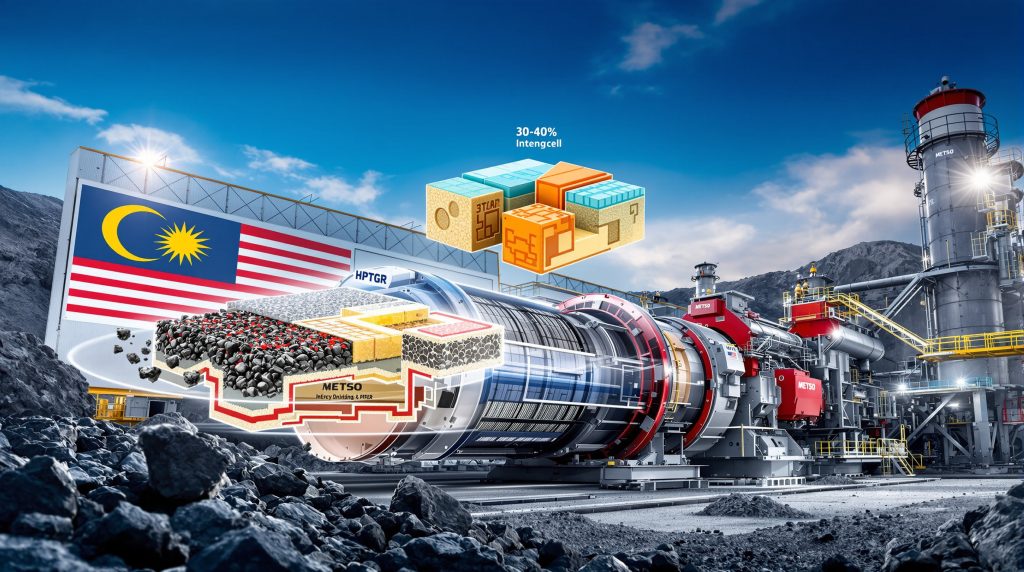Understanding Metso's HPGR Technology: A Game-Changer in Mining Efficiency
In the constantly evolving mining industry, technological advancements that improve efficiency while reducing environmental impact are becoming increasingly valuable. High Pressure Grinding Roll (HPGR) technology represents one such innovation that's transforming mineral processing operations worldwide. Metso, a global leader in mining equipment manufacturing, has recently expanded its HPGR footprint through a significant order from Fortress Minerals for two strategic projects in Malaysia.
HPGR technology operates on a fundamentally different principle than conventional grinding methods. Instead of relying solely on impact or attrition forces, HPGRs utilize high pressure between two counter-rotating rolls to crush material. This process creates micro-fractures throughout the ore particles, significantly reducing the energy required in subsequent grinding stages and improving mineral liberation.
The technology's adoption across the mining sector marks a shift toward more sustainable and cost-effective processing methods. With growing pressure on mining operations to reduce their environmental footprint while maintaining profitability, technologies like Metso's HPGR systems offer a compelling solution to these seemingly contradictory demands.
Understanding High Pressure Grinding Roll Technology
HPGR technology represents a significant advancement in comminution (the reduction of solid materials to smaller particles). Unlike conventional crushing and grinding circuits that rely heavily on ball mills, HPGRs use two counter-rotating rolls with a small gap between them. Material is fed from above and compressed between these rolls under extremely high pressure – often exceeding 100 MPa.
This compression creates a unique particle bed effect where ore particles are not only crushed by the rolls themselves but also by neighboring particles. The result is a highly efficient size reduction process that produces distinctive micro-fractures throughout the material structure. These micro-fractures significantly reduce the energy required in downstream processing, as the particles are already weakened and more susceptible to further size reduction.
Metso's HRC series incorporates several proprietary design features that enhance performance and reliability. The flanged roll design provides structural integrity while the anti-skew assembly ensures consistent pressure application across the entire roll face. These design elements contribute to more consistent product sizing and reduced maintenance requirements compared to earlier HPGR designs.
The Strategic Importance of Advanced Grinding Technology
Mining operations worldwide face increasing pressure to reduce energy consumption while maintaining or improving productivity. According to industry data, grinding typically accounts for approximately 40% of a mine's total energy usage, representing both a significant cost center and environmental impact source.
HPGR technology directly addresses this challenge by fundamentally changing how energy is transferred to ore particles during size reduction. The compression-based grinding approach is inherently more efficient than impact-based methods, resulting in substantial energy savings without sacrificing throughput or recovery rates.
Beyond pure energy considerations, advanced grinding technologies like HPGRs offer additional benefits that impact overall operational sustainability. The reduction in energy consumption translates directly to lower carbon emissions, helping mining companies meet increasingly stringent environmental regulations and corporate sustainability targets.
Water consumption – another critical sustainability factor in mining operations – can also be positively impacted by HPGR implementation. The technology typically produces a drier product with different particle characteristics than conventional grinding, potentially reducing water requirements in downstream processes.
Fortress Minerals' Strategic Implementation in Malaysia
The recent equipment order from Fortress Minerals represents a significant investment in advanced processing technology for two key Malaysian mining projects. This technology selection follows what company representatives described as "a rigorous nine-month study" focused on energy efficiency, availability, and process consistency – underscoring the strategic importance of this decision.
Bukit Besi Iron Ore Project Implementation
The Bukit Besi iron ore project represents an important development in Malaysia's mining sector. Located in Terengganu state on peninsular Malaysia's eastern coast, the project is revitalizing a historically significant mining region that was once among the world's major iron ore producers before operations ceased in the 1970s.
Fortress Minerals' implementation of Metso's HPGR technology at Bukit Besi signals a commitment to applying modern, efficient processing methods to extract maximum value from this resource. The iron ore deposits at Bukit Besi contain magnetite and hematite mineralization that requires efficient grinding to achieve proper liberation before concentration.
The HPGR installation will likely serve as a tertiary crushing stage or pre-grinding step before final grinding. This configuration optimizes the overall comminution circuit by taking advantage of the HPGR's ability to efficiently reduce particle size while inducing micro-fractures that make subsequent grinding more effective.
Mengapur Copper Project Application
The Mengapur copper project represents a diversification of Fortress Minerals' portfolio beyond iron ore. Located in Pahang state, this project aims to develop a significant copper resource with associated gold, silver, and molybdenum values.
Copper processing presents different challenges than iron ore beneficiation, particularly in terms of achieving sufficient liberation of valuable minerals from gangue material. The implementation of HPGR technology at Mengapur demonstrates its versatility across different mineral applications.
For copper sulfide ores, efficient grinding is critical to achieving proper liberation without over-grinding, which can lead to recovery losses in flotation circuits. The precise particle size distribution produced by HPGRs, combined with their energy efficiency, makes them particularly well-suited for complex polymetallic ores like those at Mengapur.
Metso's Comprehensive Equipment Package
The order secured by Metso encompasses far more than just the flagship HPGR units, representing a comprehensive processing solution tailored to the specific requirements of both projects.
Comprehensive Equipment Suite Analysis
At the heart of the equipment package are two Metso HRC High Pressure Grinding Rolls, which will serve as key components in the comminution circuits at both projects. These units incorporate Metso's latest design innovations to enhance performance, reliability, and maintenance accessibility.
The Vertimill vertical grinding mill included in the package complements the HPGRs by providing efficient fine grinding capabilities. Vertimills operate on a fundamentally different principle than conventional ball mills, using a screw-type stirrer to agitate the grinding media (typically small steel balls) in a vertical chamber. This design offers significant energy efficiency advantages for fine grinding applications, with typical energy savings of 30-50% compared to ball mills for equivalent grinding tasks.
The Stirred Media Detritor (SMD) further extends the grinding capabilities toward ultra-fine applications. SMDs are particularly effective for grinding material below 100 microns, where conventional grinding technologies become increasingly inefficient. By using small media and high-intensity stirring, SMDs can achieve the fine grinding required for optimal mineral liberation with substantially lower energy consumption than alternative technologies.
Supporting equipment in the package includes TankCell flotation cells, which will likely be employed at the Mengapur copper project for mineral separation after grinding. These units incorporate advanced design features for improved mixing, air dispersion, and froth recovery to maximize mineral recovery efficiency.
The vibrating screens, MHC hydrocyclones, and associated equipment complete the processing circuit, ensuring proper classification and material handling throughout the process. Metso's MD slurry pumps provide reliable transport of material between processing stages, a critical but often overlooked component of efficient plant operation.
Metso Plus Portfolio Integration
Most of the equipment in the delivery scope falls under Metso's Plus portfolio designation, which represents the company's premium tier of processing equipment. This classification signifies enhanced reliability features, optimized performance characteristics, and comprehensive data-driven mining operations capabilities.
The integration of multiple equipment types from a single supplier offers significant operational advantages beyond individual component performance. Compatibility between different process stages is ensured, reducing integration challenges during implementation. The unified control and monitoring systems facilitate smoother operation and more effective troubleshooting when issues arise.
Digital integration represents an increasingly important aspect of modern mineral processing operations. The Metso Plus portfolio includes advanced monitoring capabilities that enable operators to track performance metrics in real-time and identify optimization opportunities across the entire process circuit. This data-driven approach supports continuous improvement initiatives and helps maximize return on investment over the equipment lifecycle.
Selection Factors Behind Fortress Minerals' Decision
The decision to invest in advanced processing technology represents a significant commitment for any mining operation. Fortress Minerals' selection process provides valuable insights into the factors driving technology adoption in today's mining industry.
Decision-Making Process and Selection Criteria
According to Mr. Ng Mun Fey, COO and Project Leader at Fortress Minerals, the company conducted "a rigorous nine-month study into energy efficiency, availability, and process consistency" before selecting Metso as their equipment supplier. This methodical approach highlights the strategic importance of processing technology decisions and the multiple factors that influence them.
Energy efficiency clearly emerged as a primary consideration, reflecting both economic and environmental priorities. With energy typically representing 20-30% of operating costs in mining operations, technologies that can significantly reduce consumption offer compelling financial benefits alongside sustainability improvements.
Equipment availability – the percentage of time that equipment is operational and capable of performing its intended function – represents another critical factor. Unplanned downtime can cost mining operations thousands of dollars per hour in lost production, making reliability a key consideration in equipment selection.
Process consistency refers to the ability to maintain stable operating parameters and product quality despite variations in feed characteristics. Consistent processing performance is essential for downstream operations and ultimately product quality, making it a significant evaluation criterion.
The selection of Metso was ultimately attributed to "deep technical expertise, reliable product performance, and the strong support framework" – factors that extend beyond pure equipment specifications to encompass the broader supplier relationship and support infrastructure.
Energy Efficiency and Sustainability Goals
Mining companies worldwide are increasingly adopting formal sustainability targets, often including specific energy reduction goals. Fortress Minerals' focus on energy efficiency during their evaluation process aligns with this industry trend and suggests that sustainable mining transformation considerations are becoming more deeply integrated into capital investment decisions.
Kai Rönnberg, Vice President of Minerals Sales for Asia Pacific at Metso, reinforced this perspective, noting that the order exemplifies how customers are "embracing more energy-efficient and sustainable flowsheets" and aligning advanced technologies with "long-term environmental goals."
This emphasis on sustainability extends beyond regulatory compliance to include operational benefits. Energy-efficient processing not only reduces direct costs and emissions but can also improve a company's standing with investors, customers, and communities – increasingly important factors in maintaining a social license to operate.
Industry Implications of Advanced Grinding Technology Adoption
The implementation of advanced grinding technologies like HPGRs has broader implications for the mining industry beyond individual project economics.
Market Trends in Mining Equipment Technology
The mining equipment market is witnessing a definitive shift toward technologies that offer improved energy efficiency, reduced environmental impact, and enhanced digital integration capabilities. Metso's expanding HPGR footprint exemplifies this trend, with growing adoption across various mineral applications globally.
This shift reflects both technological maturation and changing industry priorities. HPGR technology has evolved significantly since its initial introduction to mining applications in the 1980s, with improvements in reliability, wear life, and control systems addressing many of the early challenges that limited adoption.
Simultaneously, rising energy costs, carbon pricing mechanisms, and corporate decarbonisation in mining commitments have strengthened the business case for energy-efficient processing technologies. What once might have been viewed primarily as an environmental benefit is increasingly recognized as a competitive advantage and financial necessity.
The integration of digital technologies represents another significant trend, with advanced monitoring, automated control, and predictive maintenance capabilities becoming standard features rather than optional add-ons. These capabilities allow operations to optimize performance continuously and address potential issues before they result in unplanned downtime.
Regional Impact on Malaysian Mining Sector
For Malaysia's mining sector, the adoption of advanced processing technologies by Fortress Minerals represents a potential catalyst for broader modernization. As one of the region's significant mining investments in recent years, these projects may serve as reference cases that influence technology decisions at other operations.
The country's mining industry has historically focused on tin, bauxite, and gold, with iron ore and copper representing areas of development with substantial growth potential. The implementation of energy-efficient processing at the Bukit Besi and Mengapur projects could strengthen the competitive position of Malaysian mining operations in regional and global markets.
Beyond direct operational benefits, the adoption of advanced technologies creates opportunities for knowledge transfer and skills development within the local workforce. As mining operations increasingly rely on sophisticated equipment and digital systems, workforce capabilities must evolve accordingly, potentially raising skill levels and compensation across the sector.
Technical Principles Behind HPGR's Transformative Potential
Understanding the fundamental mechanisms that make HPGR technology more efficient than conventional grinding approaches helps explain its growing adoption across the mining industry.
Technical Principles of High Pressure Grinding
HPGR technology achieves size reduction through a fundamentally different mechanism than conventional crushing and grinding equipment. While traditional technologies primarily use impact, abrasion, or attrition forces, HPGRs primarily utilize compression to break particles.
When material enters the gap between the counter-rotating rolls, it forms a particle bed that experiences extremely high pressure – typically 100-300 MPa. Under these conditions, particles are not only compressed by the rolls themselves but also by neighboring particles, creating a unique inter-particle comminution effect.
This compression generates extensive micro-fracturing throughout the material structure, including fractures that are not immediately visible as particle size reduction. These micro-fractures significantly weaken the material, making subsequent grinding stages more efficient as less energy is required to achieve further size reduction.
Another distinctive characteristic of HPGR processing is the formation of micro-agglomerates or "flakes" in the product. These agglomerates consist of fine particles compressed together, which can be advantageous for certain downstream processes like heap leaching where they promote better permeability while still providing sufficient surface area for chemical reactions.
Operational Benefits in Real-World Applications
The theoretical advantages of HPGR technology translate into measurable operational benefits across various applications and mineral types. While specific performance improvements vary depending on ore characteristics and circuit configuration, several common advantages have been documented across multiple implementations.
Energy efficiency represents the most widely recognized benefit, with typical reductions in overall comminution energy requirements compared to conventional crushing and grinding circuits. This efficiency stems from the fundamental mechanism of compression-based size reduction and the extensive micro-fracturing that facilitates downstream grinding.
Improved mineral liberation often accompanies HPGR implementation, as the micro-fracturing tends to occur preferentially along grain boundaries between different minerals. This selective breakage can improve liberation at coarser particle sizes, potentially increasing recovery rates in subsequent separation processes.
Operational flexibility represents another advantage, as HPGRs can effectively process materials with varying moisture content and hardness. This adaptability helps operations maintain consistent performance despite natural variations in ore characteristics – a significant operational challenge with some conventional technologies.
Wear life and maintenance requirements have improved substantially with modern HPGR designs, addressing what was historically a limitation of the technology. Innovations in roll surface materials and design have extended service intervals and reduced maintenance costs, improving overall availability and reducing operating costs.
Future Outlook for Mining Technology Innovation
The implementation of advanced grinding technologies at Fortress Minerals' Malaysian projects represents part of a broader technological evolution within the mining industry. Looking forward, several trends suggest continued innovation in this space.
Technology Evolution and Continuous Improvement
HPGR technology continues to evolve, with ongoing refinements focused on extending wear life, improving energy efficiency, and enhancing control systems. Future developments may include more sophisticated pressure profiling capabilities, allowing real-time adjustments based on feed characteristics to optimize performance.
Digital integration represents a major focus area, with advanced sensors, data analytics, and AI in mining operations increasingly being applied to optimize equipment performance. These capabilities enable more precise control, predictive maintenance, and continuous process optimization beyond what was possible with earlier generation equipment.
Remote monitoring and operation capabilities are expanding, allowing expert support regardless of physical location. This connectivity can be particularly valuable for operations in remote locations, providing access to specialized expertise without requiring on-site presence.
Sustainability-focused innovations are likely to accelerate, with equipment manufacturers investing in technologies that further reduce energy consumption, water usage, and overall environmental footprint. These developments align with mining companies' increasing focus on ESG (Environmental, Social, and Governance) performance.
Project Expansion Possibilities
For Fortress Minerals specifically, the implementation of this advanced equipment package potentially lays the groundwork for future expansion. Modular design approaches in modern processing equipment facilitate capacity increases as resource development progresses, potentially allowing incremental expansion without complete reconfiguration.
The performance results from this initial implementation will likely influence future investment decisions, both at these specific projects and across Fortress Minerals' broader portfolio. Demonstrated success with energy-efficient processing technology could accelerate adoption across additional operations.
The long-term partnership aspect highlighted by both Metso and Fortress Minerals representatives suggests a collaborative approach to ongoing optimization and potential future equipment orders. This relationship-based approach to technology implementation has become increasingly common in the mining equipment sector, recognizing that optimal performance requires more than just delivering hardware.
FAQ: Metso HPGR Technology at Fortress Minerals
What makes HPGR technology more energy-efficient than conventional grinding?
HPGR technology achieves superior energy efficiency through its fundamental operating principle of high-pressure compression. Unlike conventional crushing and grinding that rely heavily on impact forces, HPGRs create extensive micro-fractures throughout particles by subjecting them to extreme pressure between counter-rotating rolls.
This micro-fracturing significantly weakens the material structure, making subsequent grinding stages more efficient. The energy transfer mechanism is also more direct, with less energy lost as heat or noise compared to impact-based technologies like SAG mills.
The particle bed effect – where material is compressed not only by the rolls but also by neighboring particles – further enhances efficiency by creating inter-particle comminution. This mechanism is inherently more energy-efficient than the random impacts that characterize conventional grinding.
The overall system efficiency also benefits from the drier product produced by HPGRs, which can reduce energy requirements in downstream processes like classification and dewatering.
How does the Metso HRC series differ from other HPGR technologies?
Metso's HRC series incorporates several distinctive design features that differentiate it from other HPGR technologies on the market. The flanged roll design provides enhanced structural integrity and helps maintain alignment during operation, contributing to more consistent performance and reduced maintenance requirements.
The anti-skew assembly represents another key innovation, preventing roll misalignment under the extreme pressures experienced during operation. This feature helps maintain consistent gap settings across the entire roll face, resulting in more uniform product characteristics.
Advanced wear protection systems extend service life while maintaining optimal performance. The specific materials and design approaches used in the HRC series have evolved through extensive field experience across various applications and ore types.
The control systems integrated with Metso's HRC units offer sophisticated monitoring and automation capabilities that optimize performance in real-time. These systems can adjust operating parameters based on feed characteristics and downstream requirements, maximizing efficiency across varying conditions.
What integration challenges might Fortress Minerals face with this new equipment?
Integrating advanced processing technology like HPGRs into existing or new operations presents several potential challenges that require careful planning and execution. Ensuring proper material handling between process stages represents a common challenge, as HPGR products have different physical characteristics than those from conventional crushing equipment.
Circuit configuration optimization requires detailed understanding of how HPGRs interact with downstream processes. The unique particle characteristics produced by HPGRs may require adjustments to classification, grinding, and separation stages to fully capitalize on the technology's benefits.
Operational expertise development is essential, as HPGRs operate differently than conventional equipment. Operators and maintenance personnel need specific training to effectively monitor performance, identify potential issues, and optimize operating parameters.
Control system integration becomes increasingly important as operations adopt more sophisticated equipment. Ensuring seamless communication between different equipment components and centralized control systems requires careful planning and implementation.
These challenges can be successfully addressed through proper planning, training, and commissioning approaches. Metso's "strong support framework" mentioned by Fortress Minerals representatives likely includes assistance with these integration aspects to ensure successful implementation.
How will this technology impact Fortress Minerals' product quality?
The implementation of HPGR technology typically influences product quality in several positive ways that could benefit Fortress Minerals' operations. Improved mineral liberation is one of the most significant effects, as the micro-fracturing mechanism tends to break particles along grain boundaries between different minerals. This selective breakage can improve recovery rates in downstream separation processes.
More consistent particle size distribution is another common benefit, as HPGRs typically produce a narrower size range than conventional crushing equipment. This consistency helps optimize downstream processes like flotation, where performance is sensitive to feed characteristics.
For iron ore processing at the Bukit Besi project, these benefits could translate to more efficient magnetic separation and potentially higher-grade concentrate production. The improved liberation characteristics may allow Fortress Minerals to achieve desired product specifications while minimizing processing costs.
At the Mengapur copper project, the HPGR's impact on flotation feed properties could improve recovery rates for copper and associated metals. The technology's ability to enhance liberation without excessive fines generation is particularly valuable for sulfide flotation circuits.
The Future of Efficient Mineral Processing in Malaysia
The investment by Fortress Minerals in advanced processing technology marks an important step in the evolution of Malaysia's mining industry toward more efficient and sustainable operations. By implementing energy-efficient comminution technology at both the Bukit Besi iron ore and Mengapur copper projects, the company is positioning itself at the forefront of regional mining technology adoption.
This investment reflects broader industry trends toward technologies that simultaneously improve operational efficiency and environmental performance. As energy costs continue to rise and sustainability considerations become increasingly important to stakeholders, such technologies are likely to become standard practice rather than exceptional investments.
For Malaysia's mining sector specifically, the successful implementation of these advanced processing systems could serve as a catalyst for broader modernization. As a demonstration of how modern technology can improve the economics and sustainability of mining operations, these projects may influence investment decisions and technology selection across the region.
The long-term outlook for mining technology suggests continued innovation focused on further efficiency improvements, enhanced digital integration, and reduced environmental impact. Companies that establish foundations for this technological evolution today – as Fortress Minerals is doing – will likely be better positioned to implement future advancements as they emerge.
As Kai Rönnberg of Metso noted, mining companies worldwide are "embracing more energy-efficient and sustainable flowsheets" that "align with their long-term environmental goals." This alignment of operational efficiency and sustainability objectives represents a fundamental shift in how the industry approaches technology selection – a shift that will likely accelerate in coming years as both economic and environmental pressures intensify.
Interested in Maximising Your Mining Investment Returns?
Track significant ASX mineral discoveries in real-time with Discovery Alert's proprietary Discovery IQ model, ensuring you never miss another major opportunity like De Grey Mining or WA1 Resources. Explore why mineral discoveries can lead to substantial returns by visiting Discovery Alert's discoveries page.




